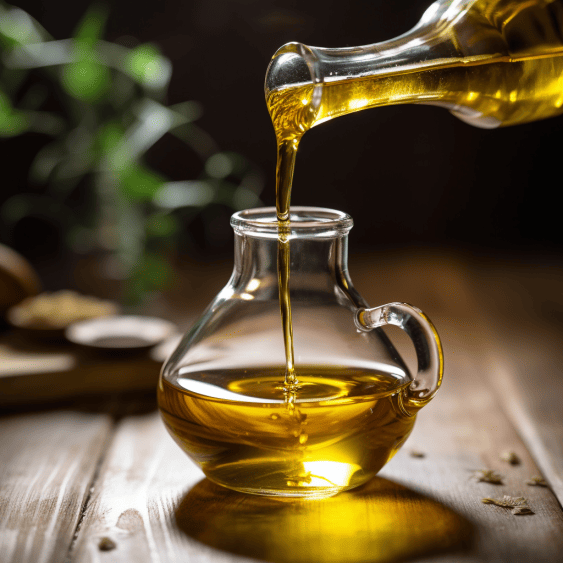What is the difference between sesame oil blend vs sesame oil?
In short, sesame oil blends combine sesame oil with other lighter oils.
Pure sesame oil provides an intense, nutty Asian flavor.
Blends create a milder, more versatile flavor for cooking.
But which is better?
As a chef, I rely on both pure and blended sesame oils.
Each has benefits depending on your recipe and taste preferences.
For stir-fries, dipping sauces, and Asian dishes, pure sesame oil shines.
Its rich, aromatic flavor really pops.
But for more delicate recipes or dressings, blended oils prevent overpowering.
Let me reveal when to use each type of sesame oil for the best results.
Discover how to shop for quality pure and blended sesame oils.
And unlock flavorful dishes with the perfect sesame oil match!
KEY TAKEAWAY
What’s the difference between sesame oil blend vs sesame oil?
Understanding the differences between sesame oil blend and sesame oil (1) is essential for making informed culinary choices.
While sesame oil blend offers a milder flavor and is often mixed with other oils, pure sesame oil provides a stronger and more distinct taste.
Flavor Profiles and Culinary Uses
Exploring the Flavor of Regular Sesame Oil
Regular sesame oil packs an aromatic, robust flavor.
The scent is nutty, earthy, and slightly sweet.
It carries a distinctive toasted sesame seed essence.
The flavor profile stands out boldly in dishes.
When cooking with regular sesame oil, a little goes a long way.
Its intensity can overwhelm more delicate ingredients.
The savory umami notes pair especially well with Asian cuisine.
Think stir fries, dipping sauces, noodle bowls, and dressings.
Nutty Notes and Aromas in Sesame Oil Blends

Sesame oil blends offer a more restrained version of the sesame flavor.
Their aroma carries a subtle, rounded nuttiness.
Top notes of toasted sesame are still detectable.
But they lack the sharp punch of pure sesame oil.
This makes sesame oil blends highly versatile in the kitchen.
Their mellowness complements without overtaking.
The flavors interplay beautifully with other ingredients.
Let’s explore ideal cooking uses for each sesame oil type.
Cooking Applications for Each Type: Regular vs Blend
When should you use regular versus blended sesame oil (2)?
Regular sesame oil shines for bold Asian dishes.
It can finish subtle recipes like fish or chicken.
Blends allow sesame nuance in lighter dishes.
They sauté well without becoming overpowering.
In dressings, dips, and sauces, blends prevent heaviness.
Trying both oils will teach your palate their differences.
With experience, you’ll know which suits your tastes and recipes.
Shelf Life, Storage, and Smoke Points
Shelf Life and Storage Considerations for Regular Sesame Oil

Like most oils, regular sesame oil has a limited shelf life.
Its all-natural composition prone it to rancidity over time.
Proper storage helps prolong freshness.
Keep sesame oil sealed in a cool, dark place.
Refrigeration can extend lifespan to about 6 months.
Look for oil packaged in tinted bottles or cans.
Light exposure accelerates spoilage.
Smell and taste regularly for any “off” notes signaling deterioration.
Extending Shelf Life with Sesame Oil Blends
One perk of blended sesame oils is an improved shelf life.
The neutral vegetable oils resist rancidity better than sesame alone.
Blends stay fresh in pantry storage up to a year unopened.
Once opened, blends last 4-6 months refrigerated.
Their shelf stability makes buying in bulk more practical.
Just transfer smaller amounts to use within a few months.
Comparing Smoke Points for Cooking with Sesame Oil Types
Smoke point also differs between oil types.
Pure sesame oil’s smoke point falls around 350°F.
So it can only be used for low-to-mid heat cooking.
Blended sesame oils have smoke points up to 400°F.
Their higher smoke points accommodate more cooking methods.
You can use just small drizzles of regular sesame oil to finish recipes requiring higher heat.
Let’s next explore substituting and enhancing with sesame oil blends!
Substituting and Enhancing with Blended Sesame Oil
Substituting Regular Sesame Oil with Blended Varieties
Sesame oil blends make an excellent substitute for regular sesame oil in lighter dishes that would be overpowered by intense sesame flavor.
Their versatility also allows cooking at higher heats.
For example, a orange chicken stir fry recipe may call for a teaspoon of sesame oil.
But the strong flavor could clash with the bright citrus sauce.
Swapping in a blend lets you retain a hint of nuttiness without overwhelming.
Similarly, a salad dressing recipe requiring sautéed ingredients right in the dressing could cause regular sesame oil to burn and turn bitter when cooked.
A blend would provide floral aroma without tasting scorched.
Experiment with using less of a blend than you would pure sesame oil since the flavor concentrates.
Start with 3/4 the amount and adjust to taste.
With the right balance, you still get lovely sesame essence without the risk of harshness.
Enhancing Dishes with Nutty Undertones: Sesame Oil Blend Tips
Sesame oil blends add wonderful subtle enhancement to all kinds of dishes in place of other oils:
Veggie stir fries pop with a touch of toasty sesame aroma. Blends nicely caramelize the exterior without overtaking the fresh veggies.
Homemade salad dressings and marinades shine with added body and nutty richness from a blend.
Sauté chicken, pork, or tofu in a blend for a lovely hint of savory sesame flavor.
Use small amounts of a blend for dipping sauces to let the main ingredients shine while adding background depth.
Mix a spoonful into rice pilaf or fried rice for extra aromatic flavor.
Drizzle over grilled meats, seafood, or veggies right before serving to accentuate taste.
Let me know if you would like me to cover the final section on choosing the right sesame oil.
Here is the expanded section with commas replaced:
Choosing the Right Sesame Oil for Your Culinary Creations
When deciding between using regular pure sesame oil versus a blended sesame oil in your cooking, there are several important factors to consider:
Flavor Intensity – Do you want the dish to have a very pronounced, aromatically nutty sesame flavor?
Or do you prefer more delicate sesame essence in the background?
Pure sesame oil will provide intense sesame flavor, while blends create subtle nutty undertones.
Heat Level – Will you be cooking the dish at high heat, adding the oil at the end, or using it unheated?
Regular sesame oil has a relatively low smoke point for cooking.
Blends can withstand higher heat.
For pure sesame flavor in cooked dishes, use just a drizzle at the end.
Dish Profile – Is your planned recipe highly seasoned, citrusy, spicy, fatty, or more delicately flavored?
You want to select an oil that will complement the core flavors.
Pure sesame may overwhelm delicate ingredients.
Personal Taste – Try recipes with both regular and blended sesame oil to determine which sesame flavor intensity you prefer.
This comes down to individual palate.
Budget – Pure sesame oil tends to cost more than versatile blended oils.
If you cook frequently with sesame oil, blends may be more affordable.
Application – Blended sesame oils work beautifully for massage oils, dressings, dips, and sauces where you want milder sesame essence.
For the widest range of cooking options, keep both regular pure sesame oil and blended sesame oil stocked.
Use a touch of regular sesame oil at the end for intense flavor in Asian noodle and rice dishes.
Take advantage of blended oils for higher heat cooking methods and lighter recipes needing just a sesame accent.
With the right techniques for each type, you can make your cooking really sing!
If you have spilled out of sesame oil and don’t know how to clean, then check out the article about how to clean sesame oil stain.
Conclusion
Now you’re ready to elevate your cooking with the ideal sesame oil for each recipe.
Pure sesame oil brings intense aroma and flavor.
Sesame oil blends provide versatility and subtle nuttiness.
Match the oil to your dish’s needs and personal taste preferences.
For maximum fresh sesame flavor, store carefully and use within a few months.
With this know-how, you can shop for and use both types of oils like a pro.
Want more tips for using versatile sesame oil in your cooking?
Check out my next article, “Sesame Oil“.
You’ll find recipes and techniques for maximizing this nutty Asian staple.
Let’s keep exploring the culinary power of sesame!
References
- https://www.marthastewart.com/1537985/sesame-oil-about-toasted-untoasted#:~:text=Reach%20for%20regular%20sesame%20oil,vastly%20changes%20the%20oil’s%20flavor.
- https://www.webstaurantstore.com/article/454/types-of-cooking-methods.html
Related Articles
- https://bowlakechinese.com/best-way-to-clean-sesame-oil/
- https://bowlakechinese.com/sesame-oil/
- https://bowlakechinese.com/low-sodium-chinese-food-products/
Was this helpful?

I am a skilled chef assistant with a passion for Asian cuisine, I have honed my craft through formal training at At-Sunrice GlobalChef Academy and years of experience in the culinary industry. I have extensive knowledge of cooking techniques and herbs and spices, with a particular focus on traditional Chinese dishes. I’m also an author of the book “Delicious Keto Low Carb Chinese Food for Busy Moms and Fitness Enthusiasts” which is sold on Amazon. On my blog, bowlakechinese.com, I share my expertise in Asian cuisine and provide tips and recipes for those interested in low carb Chinese cuisine.

